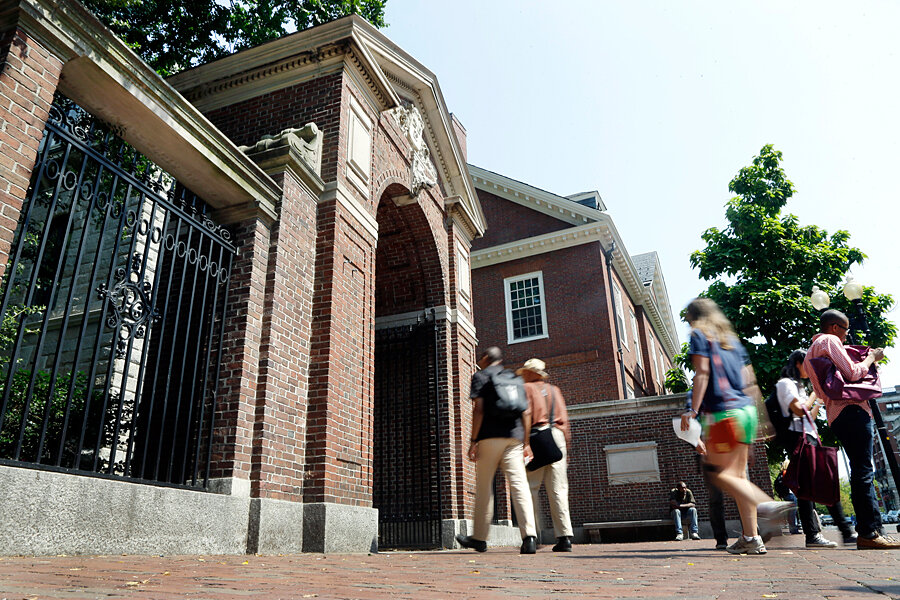What is America's top college? Depends on who is doing the ranking
Loading...
For the 30th time, US News & World Report will issue its annual ranking of America’s colleges and universities on Tuesday.
Readers can wait with bated breath to see if Princeton (last year’s No. 1) will retain its top spot, or if it will juggle places with Harvard and Yale, the other two perennially in the top three.
But while the US News rankings remain the most known of the rankings, they’re increasingly getting not only criticism – some education observers have long blamed them for negatively impacting college affordability – but also competition.
This year, Money Magazine compiled its own list, emphasizing outcomes over more nebulous criteria like reputation, and weighing data that pertains to educational quality, affordability, and career earnings.
The top three? Babson College, Webb Institute, and the Massachusetts Institute of Technology. Princeton, Stanford, and Harvard quickly follow, but lesser-known schools like New York’s Cooper Union and Harvey Mudd College in Claremont, Calif., rank well ahead of Yale (No. 15).
The goal, wrote the Money editors, was “to give students and parents a much better indication of which colleges will provide real value for their tuition dollars and enhance a student’s earning potential.”
Washington Monthly, which has been ranking colleges since 2005, also uses a different sort of criteria in ranking its schools – based on how well colleges deliver on three public goods: social mobility, commitment to research, and commitment to service. It now also gives special attention to the best “bang for your buck” schools.
Forbes, Newsweek, and The Princeton Review all have their own lists.
And the federal government is getting into the game, too. After a bus tour last fall in which he called attention to college affordability, and the growing problem of increased student debt and spiraling college costs, President Obama unveiled a plan to start rating colleges based on things such asrati college completion rates and sticker price.
"We’re going to start rating colleges not just by which college is the most selective, not just by which college is the most expensive, not just by which college has the nicest facilities – you can get all of that on the existing rating systems. What we want to do is rate them on who's offering the best value so students and taxpayers get a bigger bang for their buck,” Obama said at the time.
Developing that system has been more complicated than the administration expected, and the Education Department recently announced that it would be releasing a draft later than expected, with the complete ratings scheduled to be in place before the beginning of the 2015 school year.
The idea – along with serving as an informational tool for students and an incentive for colleges to do better – is that eventually, Congress could pass legislation tying federal aid to those ratings, and disqualifying the worst schools. It’s a major reason most colleges have been opposed to the idea. In March, the American Council on Education issued a scathing report on the proposed ratings, detailing the harm that has come from other ranking systems – such as US News – and questioning the proposed system’s ability to be useful, accurate, or impartial, particularly since it is designed to serve both consumers and policymakers.
In an attempt to highlight how difficult the government’s task will be, particularly in ferreting out the worst performers and the colleges that theoretically might be disqualified from receiving federal aid dollars, Washington Monthly this year tried to compile a list of America’s worst schools. Assigning different degrees of importance to four key measures – net price, average student debt, loan default rate, and graduation rate – the magazine came up with very different lists.
“Some nonselective colleges produce admirable graduation rates at an affordable price to students. Others are lucky to see one-fifth of starting students on through to graduation. Some charge sky-high prices and graduate students with large amounts of debt while others may be quite cheap,” Ben Miller wrote in Washington Monthly. He argued that shining a spotlight on some of the institutions that perform the poorest on these measures may actually do a far greater service to families who might otherwise apply to them than parsing the small differences among top colleges.






